
Field hockey is a team sport structured in standard hockey format, in which each team plays with 11 players in total, made up of 10 field players and a goalkeeper. Teams must move a hockey ball around a pitch by hitting it with a hockey stick towards the rival team's shooting circle and then into the goal. The match is won by the team that scores the most goals. Matches are played on grass, watered turf, artificial turf, or indoor boarded surface.

Gaelic football, commonly known as simply Gaelic, GAA or Football is an Irish team sport. A form of football, it is played between two teams of 15 players on a rectangular grass pitch. The objective of the sport is to score by kicking or punching the ball into the other team's goal or between two upright posts above the goal and over a crossbar 2.5 metres above the ground.
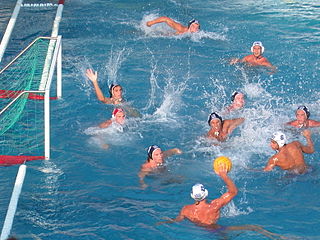
Water polo is a competitive team sport played in water between two teams of seven players each. The game consists of four quarters in which the teams attempt to score goals by throwing the ball into the opposing team's goal. The team with the most goals at the end of the game wins the match. Each team is made up of six field players and one goalkeeper. Excluding the goalkeeper, players participate in both offensive and defensive roles. It is typically played in an all-deep pool where players cannot touch the bottom.

In many team sports that involve scoring goals, the goalkeeper is a designated player charged with directly preventing the opposing team from scoring by blocking or intercepting opposing shots on goal. Such positions exist in bandy, rink bandy, camogie, association football, Gaelic football, international rules football, floorball, handball, hurling, field hockey, ice hockey, roller hockey, lacrosse, ringette, rinkball, water polo, and shinty, as well as in other sports.

Forwards are outfield positions in an association football team who play the furthest up the pitch and are therefore most responsible for scoring goals as well as assisting them. As with any attacking player, the role of the forward relies heavily on being able to create space for attack. Their advanced position and limited defensive responsibilities mean forwards normally score more goals on behalf of their team than other players.

A midfielder is an outfield position in association football. Midfielders may play an exclusively defensive role, breaking up attacks, and are in that case known as defensive midfielders. As central midfielders often go across boundaries, with mobility and passing ability, they are often referred to as deep-lying midfielders, play-makers, box-to-box midfielders, or holding midfielders. There are also attacking midfielders with limited defensive assignments.
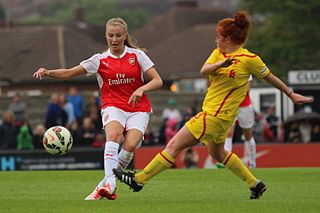
In the sport of association football, a defender is an outfield player whose primary role is to stop attacks during the game and prevent the opposition from scoring.
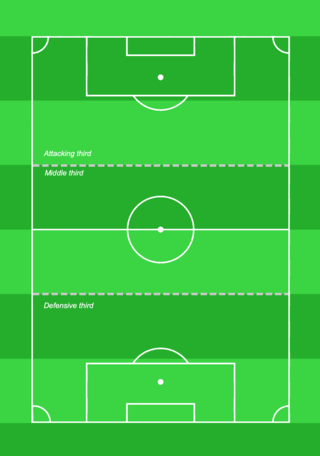
Team tactics as well as individual skills are integral for playing association football. In theory, association football is a very simple game, as illustrated by Kevin Keegan's namely assertion that his tactics for winning a match were to "score more goals than the opposition". Tactical prowess within the sport is nonetheless a craftsmanship of its own, and one of the reasons why managers are paid well on the elite level. Well-organised and ready teams are often seen beating teams with more skillful players on paper. Manuals and books generally cover not only individual skills but tactics as well.
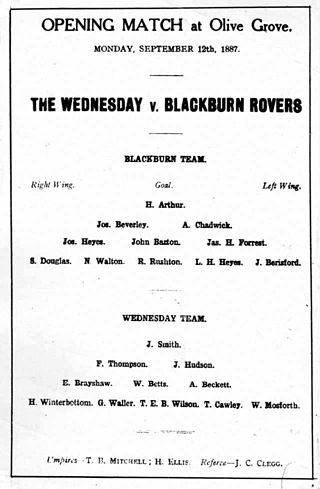
In association football, the formation of a team refers to the position players take in relation to each other on a pitch. As association football is a fluid and fast-moving game, a player's position in a formation does not define their role as tightly as that of rugby player, nor are there breaks in play where the players must line up in formation. A player's position in a formation typically defines whether a player has a mostly defensive or attacking role, and whether they tend to play centrally or towards one side of the pitch.

In the sport of association football, each of the 11 players on a team is assigned to a particular position on the field of play. A team is made up of one goalkeeper and ten outfield players who fill various defensive, midfield, and attacking positions depending on the formation deployed. These positions describe both the player's main role and their area of operation on the pitch.

In the game of rugby union, there are 15 players on each team, comprising eight forwards and seven backs. In addition, there may be up to eight replacement players "on the bench", numbered 16–23. Players are not restricted to a single position, although they generally specialise in just one or two that suit their skills and body types. Players that play multiple positions are called "utility players".
In certain sports, such as football, field hockey, ice hockey, handball, rugby union, lacrosse and rugby league, winger is a position. It refers to positions on the extreme left and right sides of the pitch, or playing field. In American football and Canadian football, the analogous position is the wide receiver. Wingers often try to use pace to exploit extra space available on the flanks that can be made available by their teammates dominating the centre ground. They must be wary however of not crossing the touchline, or sidelines, and going out of play. In sports where the main method of scoring involves attacking a small goal in the centre of the field, a common tactic is to cross the ball to a central teammate.
A rugby league team consists of 13 players on the field, with 4 substitutes on the bench. Each of the 13 players is assigned a position, normally with a standardised number, which reflects their role in attack and defence, although players can take up any position at any time.
In sports, a utility player is one who can play several positions competently. Sports in which the term is often used include association football, basketball, American football, baseball, rugby union, rugby league, softball, ice hockey, and water polo.

In sports, a starting lineup is an official list of the set of players who will participate in the event when the game begins. The players in the starting lineup are commonly referred to as starters, whereas the others are substitutes or bench players.

In the sport of Australian rules football, each of the eighteen players in a team is assigned to a particular named position on the field of play. These positions describe both the player's main role and by implication their location on the ground. As the game has evolved, tactics and team formations have changed, and the names of the positions and the duties involved have evolved too. There are 18 positions in Australian rules football, not including four interchange players who may replace another player on the ground at any time during play.
In association football, a playmaker is a footballer who controls the flow of the team's play, and is often involved in offensively and defensively playing passing moves which lead to goals, through their vision, technique, ball control, creativity and passing ability.

This list is an alphabetical glossary of Australian rules football terms, jargon and slang. While some of these entries are shared with other sports, Australian rules football has developed a unique and rich terminology.

Squad numbers are used in association football to identify and distinguish players that are on the field. Numbers very soon became a way to also indicate position, with starting players being assigned numbers 1–11, although in the modern game they are often influenced by the players' favourite numbers and other less technical reasons, as well as using "surrogates" for a number that is already in use. However, numbers 1–11 are often still worn by players of the previously associated position.
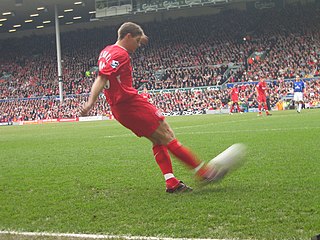
In association football, a cross is a medium- to-long-range pass from a wide area of the pitch towards the centre of the field near the opponent's goal. Specifically, the intention of a cross is to directly bring the ball into the box from an angle that allows the attacking forwards to more easily aim for goal with their head or feet. Crosses are generally airborne (floated) to clear nearby defenders, but can also be hit with force along the ground (drilled). It is a quick and effective move.


















